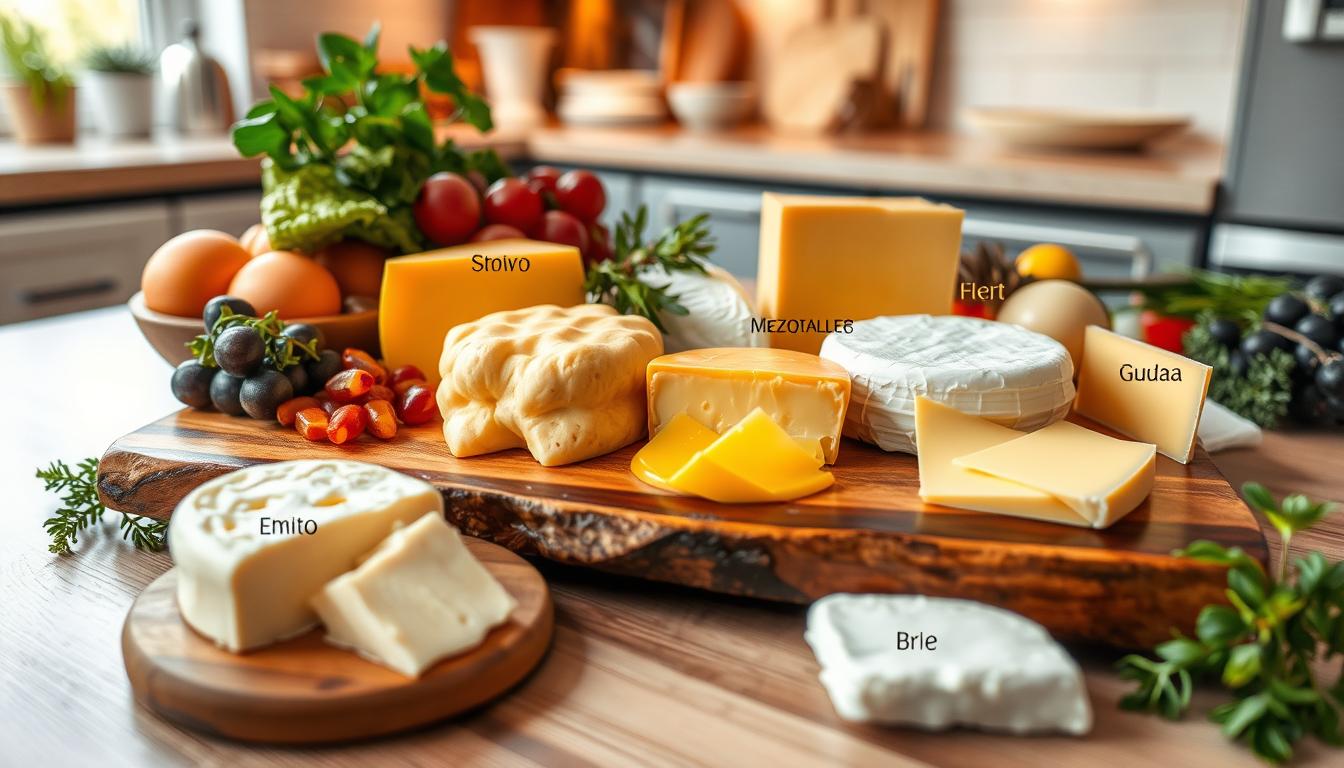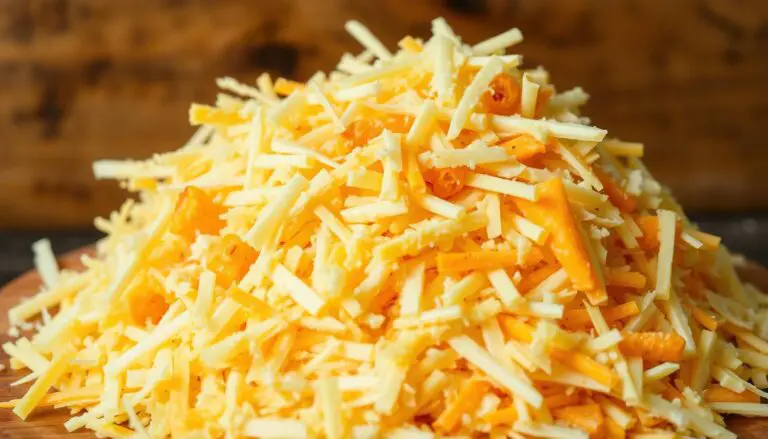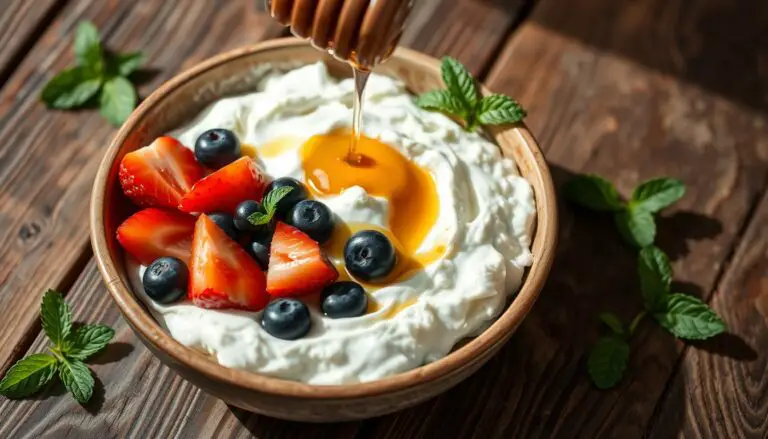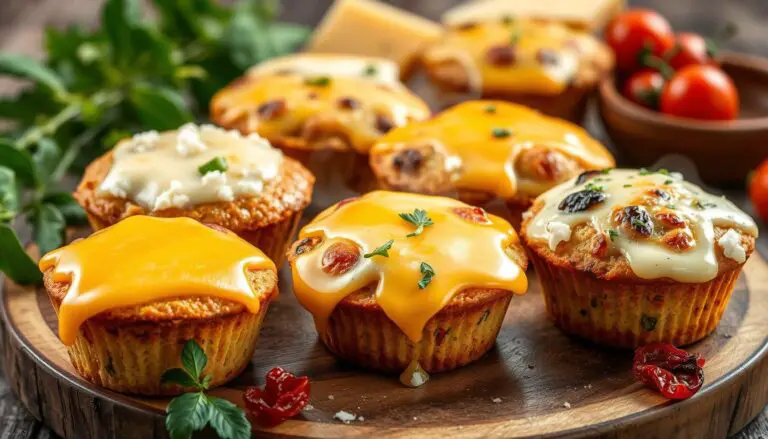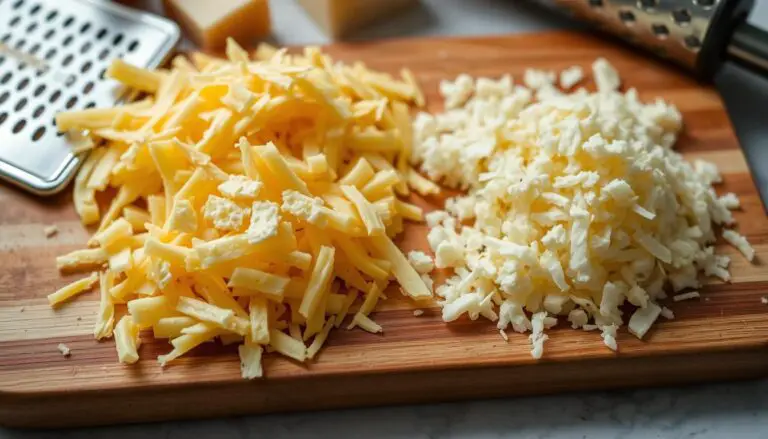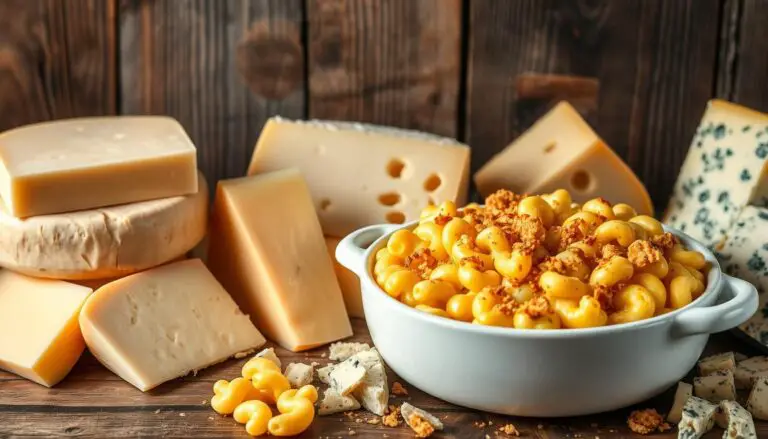Discover Cheese Melting Points: A Tasty Guide
Ever wondered why some cheeses melt well while others just get gooey? Knowing about cheese melting points can make a big difference. With almost 2,000 types of cheese worldwide (including 750 in the UK)1, it’s key to learn about each type’s melting traits. Cheeses like mozzarella melt beautifully, while aged cheddar adds sharp flavors.
Curious about how moisture and pH levels affect melting? Or how some cheeses are great for grilling? You’re in the right spot. Learn how to get that perfect melt in your cooking. For more on cheese, check out this guide on cheese types and their heat reactions.
Key Takeaways
- Understanding cheese melting improves cooking skills and dish quality.
- Different cheeses melt at various points due to their moisture and protein.
- Aging and acidity levels greatly affect cheese’s heat behavior.
- Popular cheeses like Cheddar and Mozzarella have unique traits to master.
- Using the right cooking methods can enhance melted cheese dishes.
- It’s important to follow food safety when storing and using cheese.
The Science Behind Cheese Melting Points
To understand cheese melting points, we need to look at protein structures and temperature effects. Each cheese type has its own unique traits, thanks to its protein makeup, mainly casein. When heated, the cheese melts, needing the right temperature and using its natural properties.
Understanding Protein Structures
The melting of cheese happens in stages. Fats melt at room temperature, while proteins soften at hot tap water. Complete melting is usually around 160°F (71°C)2.
Cheese with the right calcium phosphate bonds melts well. But, too much or too little calcium can mess with melting. Too much makes it hard to melt, and too little makes it too runny2.
The Role of Temperature in Melting
Temperature is key for good cheese melting. For example, cheddar cheese melts at about 150°F (66°C)3. Young, moist cheeses like non-aged cheddar, Colby, and mozzarella melt best.
Keeping cheese at 165-170°F (74-77°C) with sodium citrate makes smooth sauces3. Heating cheese gently gets it gooey, but too much heat makes it greasy. Adding moisture helps make the sauce smooth and pourable without separating3.
Different Cheese Types and Their Melting Qualities
Cheese varieties greatly affect how well they melt. They are divided into high and low moisture cheeses. Knowing this can make your cooking better and taste richer.
High Moisture Cheeses
High moisture cheeses like mozzarella and young Gouda melt really well. They have a lot of water, which makes them creamy and stretchy when heated. This makes them great for many dishes.
Fresh mozzarella is famous for its taste and melting. It’s perfect in dishes like Roasted Vegetable Lasagne and Classic Paninis4. Fontina Val d’Aosta is also great, with a nutty flavor and excellent meltability4. Danish Havarti is another good choice for its melt.
Cheeses like Gruyère and Comté melt well too. They’re great in French Onion Soup and Cheese Fondue5.
Low Moisture Cheeses
Low moisture cheeses, like aged Parmesan and Gouda, melt differently. They have less water and are firmer, so they don’t melt as smoothly. Aged Gouda is sweet and still melts a bit, making it good for grating6.
Asiago pressato melts well, unlike its aged version4. But cheeses like aged Parmigiano-Reggiano are better for adding flavor than melting4.
| Cheese Type | Description | Melting Qualities |
|---|---|---|
| Fresh Mozzarella | Soft, creamy cheese with high moisture content | Excellent melt with stretch and flavor |
| Young Gouda | Sweet and buttery cheese, higher water content | Outstanding melting properties |
| Fontina Val d’Aosta | Nuttier, firmer cheese from Italy | Exceptional meltability |
| Aged Parmesan | Hard cheese with low moisture, intense flavor | Less suitable for melting; better for grating |
| Asiago Pressato | Young, mild cheese with smooth melting qualities | Provides a smooth melt |
Factors Influencing Cheese Melting Points
Knowing what affects cheese melting is key for cooking and food science. The age and moisture of the cheese are important. Younger cheeses melt better because they have more moisture and a softer protein structure.
As cheese ages, it loses moisture and becomes firmer. This makes it harder to melt. Cheesemakers know that moisture and fat levels are key for melting78.
Age and Moisture Content
Aging changes how cheese melts. Over time, it loses moisture and gets denser. This can make it harder to melt.
Moist cheeses like Brie melt well because of their high moisture. Aged cheeses, however, melt less because they are denser. Knowing about moisture is important for choosing cheeses to melt.
The Impact of pH Levels
The pH of cheese also affects melting. High acidity can make it hard for cheese to melt. This is why cheeses like Cottage Cheese stay firm.
On the other hand, cheeses with the right pH melt better. They have the right balance of protein and fat. This makes them melt smoothly. pH is important for meltability and stretch8.
Popular Cheeses and Their Melting Points
Cheeses differ a lot in how they melt, which affects their use in cooking. Knowing how popular cheeses melt can make your dishes better. Here are some well-known cheeses, their melting points, and how they’re used in cooking.
Cheddar Cheese Melting Characteristics
The cheddar melting point is low, making young cheddar great for creamy dishes. Young cheddar, aged one year or less, melts well for grilled cheese and mac and cheese9. It’s loved for its rich taste and smooth melt.
Understanding Mozzarella’s Melting Point
Mozzarella is famous for its melting, especially its stretchiness. This is perfect for pizza and baked dishes. Its high moisture content makes it melt well10. It also creates a great cheese pull in many recipes.
Gruyère and Fontina: Ideal Melting Cheeses
Gruyère and Fontina are known for melting well, often used in cheesy sauces and fondues. Gruyère, aged five to 18 months, has a nutty taste and melts beautifully11. Fontina, aged about 80 days, adds a creamy texture to pasta and dips11. They’re favorites among chefs and home cooks.
Cheese Melting Points Across Different Temperatures
Knowing the melting points of various cheeses is key for great cooking results. Each cheese reacts differently to heat, affecting how they work in recipes. For instance, Cheddar is great in soups because it melts well and tastes strong.
Other cheeses like Swiss, Fontina, and Colby also melt well. This makes them add flavor to dishes12.
Optimal Melting Temperatures for Various Cheeses
Cheeses melt at different temperatures, which affects their use in cooking. Dairy Cheddar and plant-based Cheddar melt similarly when heated from 20 °C to 80 °C. This shows they can be used in many recipes13.
Moisture content is also important. Aged cheeses like Parmesan have low moisture. This makes them melt into a soft, creamy texture when heated14.
But, high melting point cheeses like Pecorino don’t melt well in soups. They can become grainy12.
What Happens When Cheese is Overheated
Overheating cheese can cause problems, like separation and greasiness. When cheese like D-Slice or V-Cheddar melts, it doesn’t go back to its original state after cooling13. This can make the cheese unpleasant to eat.
To avoid this, it’s important to heat cheese gently. Keeping the temperature right helps keep the cheese’s good qualities and prevents it from separating too much14.
Culinary Applications of Melted Cheese
Melted cheese is a key ingredient in many dishes. It adds rich flavor and creamy texture. Learning to make the perfect cheese sauce can make any meal special.
Making the Perfect Cheese Sauce
To get a smooth cheese sauce, use cornstarch or sodium citrate. These help mix the cheese well. American cheese is great because it melts easily, making the sauce smooth.
Delicious Dishes Featuring Melted Cheese
Melted cheese is great in many dishes. Fondue and grilled cheese are favorites. They show how melted cheese can add unique flavors to meals.
Combining Cheeses for Unique Melting Experiences
Trying different cheese mixes can make dishes better. Mixing mozzarella, cheddar, and fontina creates new tastes. It’s a fun way to find your favorite cheese combinations.
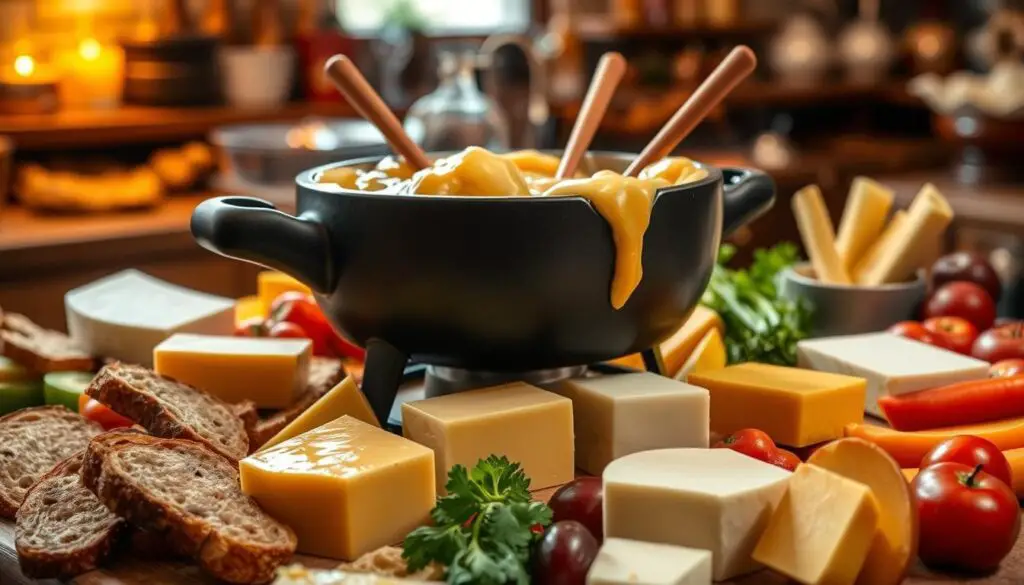
Different Melting Techniques for Cheese
Melting cheese right is all about knowing the right techniques. Two main methods are slow cooking and high heat. Each has its own benefits and challenges when working with cheese.
Slow Cooking vs. High Heat
Slow cooking helps cheese melt evenly, keeping its taste and texture. Cheese starts to soften at about 90°F (32°C). High heat, which can reach 150°F (66°C) for cheeses like cheddar3, can cause separation or burning. Harder cheeses like Gruyere and Cheddar are best for slow cooking because they stay good under controlled heat15.
The Importance of Grating and Room Temperature
Grating or shredding cheese makes it melt faster and more evenly15. It’s also key to let cheese warm up to room temperature before melting. This lowers the melting heat, making it better. Using a non-stick skillet helps prevent sticking and uneven melting15.
To get the best melt, mix cheese with sodium citrate or starch. These help with texture and stability when melted3. Adding milk or something acidic can also make the cheese smooth and creamy.
| Melting Techniques | Best For | Tips |
|---|---|---|
| Slow Cooking | Preserving texture and flavor | Maintain low temperatures to avoid burning |
| High Heat | Quick melting for specific cheeses | Use cautiously to prevent separation |
| Grating Cheese | Faster, even melting | Maximize surface area by shredding |
| Room Temperature | Improved melting consistency | Let cheese sit out before cooking |
Knowing these melting techniques can make your cheese dishes better. It adds a delicious texture that makes your food even more enjoyable3158.
Understanding Cheese Textures and Melting
Cheese textures and melting properties are quite interesting. Aging affects how cheeses melt. As cheeses age, they get firmer, changing how they melt when cooked.
Consequences of Aging on Texture
Aging cheese changes its texture a lot. Younger cheeses melt better because they are softer and wetter. Cheeses like Brie and Camembert melt well because of their soft, moist texture8.
On the other hand, older cheeses like Parmesan or aged cheddar melt less well. They are drier and have a firmer texture8. When heated too much, they can become grainy or oily8.
Different Texture Profiles and Their Melting Reactions
Cheese textures vary from soft to hard, each melting differently. Soft cheeses like fresh mozzarella melt well and are creamy. Firm cheeses like cheddar need careful heating to melt right3.
Non-aged cheeses like Colby and Monterey jack melt well because they are moist. They melt at lower temperatures3. Shredded cheese melts faster because it has more surface area3.
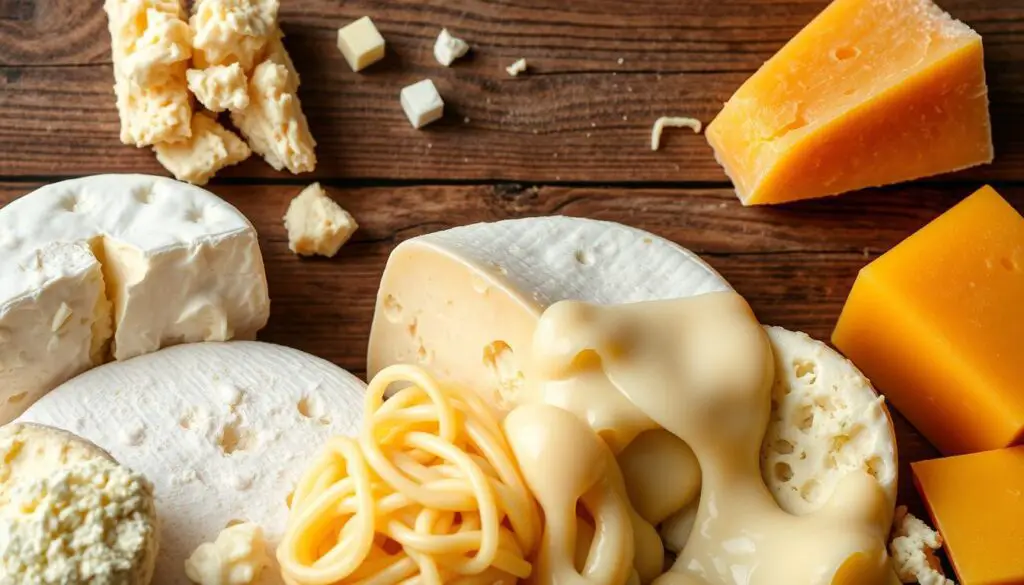
Adding melting salts like sodium citrate can make cheese melt better. This leads to smooth sauces that reheat well3. Knowing about cheese textures helps chefs pick the best cheese for melting. This ensures great cheese experiences every time38.
Food Safety Considerations When Melting Cheese
It’s important to keep food safe when melting cheese. This is especially true to avoid cross-contamination risks. When using raw cheese, it’s key to watch how it interacts with other foods. Following safe handling practices can make melted cheese more enjoyable.
Avoiding Cross-Contamination
Some people worry about pre-melted cheese becoming rubbery. This happens because of refrigeration and reheating. It’s also a risk if raw cheese touches heat-treated foods, like chicken, without being fully melted16.
To stay safe, melt cheese fresh instead of reheating it. This way, you get better texture and taste16. Also, add shredded cheese to cooled chicken to avoid high temperatures that can cause bacteria growth16.
Ideal Storage Conditions for Cheese
Storing cheese right is crucial for its quality and safety. Cheeses like non-aged cheddar and mozzarella melt well but need careful storage3. On the other hand, cheeses like Parmesan and Romano burn easily and don’t melt well in some cases15.
Letting cheese warm up before melting helps it melt evenly15. Using a non-stick skillet and low heat can prevent sticking and ensure smooth melting15. These steps help cheese lovers enjoy a safe and tasty melting experience.
Conclusion
Learning about cheese melting points gives you culinary insights to improve your cooking. This article explained the science behind cheese melting. It showed how moisture, age, and pH levels affect melting.
Whether you’re making pizza or cheese sauce, choosing the right cheese is key. The right cheese and melting methods can make your dishes better.
With the rise of plant-based cheeses, it’s important to know how they compare. These alternatives meet dietary needs but traditional cheeses still have a big role in cooking.
Now that you know about cheese melting points, you can make your cheese dishes better. Try new techniques and cheeses. Enjoy the flavors that perfectly melted cheese adds to your cooking17.

